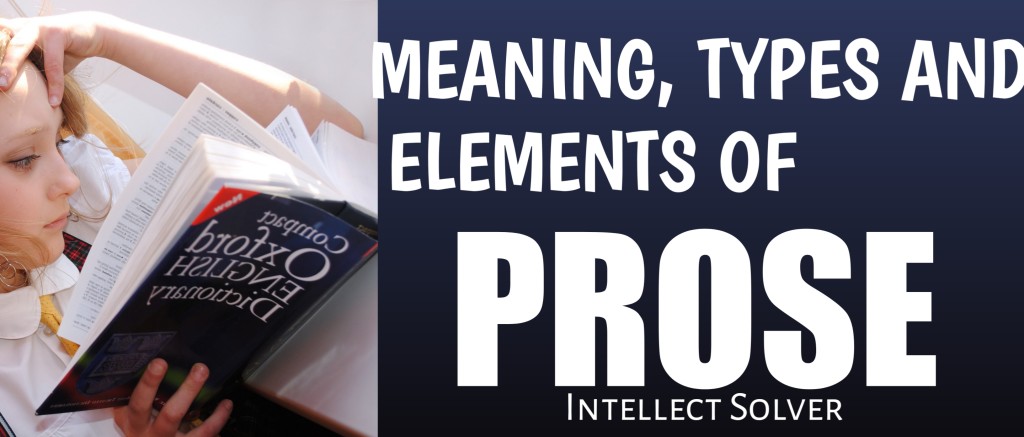MEANING
What is a Prose?. A prose is a literary piece which is written in a straight-forward language that has a lot of variety of rhythm and devoid of a specific regular pattern. It is usually written in the ordinary language that is used for everyday conversation.
TYPES OF PROSE
A prose work has many types. However, we will categorize them into five types here. There are the narrative, descriptive, argumentative, dramatic and technical. Let us look at what they entail.
(1). NARRATIVE PROSE:
This is a type that tells a story or an event which took place. It sheds light on a particular theme or subject matter. For instance, a passage on how one’s holiday was spent.
(2). DESCRIPTIVE PROSE:
Here, detailed and clear information is given to describe a true picture of person, things or place. A passage that talks about Lagos, its environs, economy, etc is a descriptive essay.
(3). ARGUMENTATIVE PROSE:
This prose presents the two sides of argument on a particular subject matter with an intention to reach a logical conclusion. The subject matter is called a proposition.
(4). DRAMATIC PROSE:
This is a prose that is written in a dialogue manner, just like drama. Quotation marks (“”) are used to denote what each speaker said.
(5). TECHNICAL PROSE:
This is a type of prose that is written with the terminology of a particular profession or field. It is usually termed as expert knowledge as only those in that profession can easily understand the written work. A prose work on the structural framework of an airplane can be understood easily by an aeronautical engineer; someone not in the field would find it difficult comprehending.
ELEMENTS OF PROSE
The elements of prose refers to the features, characteristics and constituents of a prose work. What makes a prose a prose and differentiates it from other genres of literature? Those are the elements. Now, the elements of a prose would be looked into detailed.
(1). PLOT:
A plot refers to the event that makes up a prose work, especially as they relate to each other. It makes it possible for one event to lead to another in a logical sequence, such that the reader is carried along in the turn of events. A plot may be in simple form or complex form, particularly in the aspect of narrative prose.
- A simple plot is one where the events are presented from the beginning of how things started down to the end. This type of plot follows a logically sequential format.
- A complex plot is one in which events can be told from when they ended, to how everything started. Sometimes, it could be from the middle, then the end and then the beginning.
(2). SENTENCE:
A sentence is a grammatically complete series of words containing a subject, predicate and a finite verb and always starts with a capital letter to end with a full stop, question mark, exclamation mark. An example is: ‘Charles(subject) ate(finite verb) the bread (predicate).’
In prose work, a sentence could be used to make a statement, ask questions, exclaim, etc. Sentences could either be a simple, compound, complex or compound-complex sentence.
(3). NARRATIVE TECHNIQUE:
This is the style or method that an author uses to tell his stories or present his idea. In analyzing a prose work, especially a narrative prose or novel, it is important to identify the narrative technique employed by the author of the work.
There are three outstanding narrative techniques: omniscient narrative technique, first-person narrative technique, third-person narrative technique.
- Omniscient narrative technique is one in which the writer narrates a story in such a way which shows that he knows the plot of the story and the thoughts, actions and personality of the characters. In this technique, the author is all-seeing, all-knowing and tells the readers as much as he wants them to know. Thomas Hardy used this technique in Tess of the d’Urbervilles.
- The first-person narrative technique is a limited and subjective technique. Here, the author tells the story through one of the characters in the written work. The pronouns ‘I’ and ‘we’ is used in telling the story. How much the readers would know is dependent on what the character-narrator wants them to know. Dafoe’s Robinson Crusoe used this technique.
- In the third-person narrative technique, the writer does not connect himself with the characters in the story unlike the first-person narrative technique.
(4). PARAGRAPH:
A prose work is usually presented in paragraphs to maintain clarity and logical sequence in the work. A paragraph is a passage of a written work containing a particular subject or thought idea and is usually identified by starting on a new line after the preceding text or indenting the first line where it is started. Each new paragraph contains group of related ideas.
(5). CHARACTER:
A character refers to a (fictional) person in the prose work. The characters help the readers to understand the plot and the themes of the written work. The art of creating characters is called characterization. In a story, there are several types of characters that could appear.
- A flat character is a minor character that does not undergo changes in the course of the story.
- A round character is dynamic and can exercise several personality traits as the story unfolds.
- The protagonist is the main person around which the plot of the story revolves.
- The antagonist is the villain in the story and he works against the main character (protagonist).
- The foil character is a contrast to the main character. He is not the main villain but exists to show the qualities of the main character in contrast to his own. In Harry Potter, Draco Malfoy is a foil to Harry Potter, the protagonist.
These are the meaning, types and elements of prose. I am you gained value.

